This is a Mamiya 6 Model V, a medium format roll film folding camera, produced by Mamiya Optical Co., Ltd. in Tokyo, Japan between the years 1953 and 1955. The Mamiya 6 series dates back to 1940 and received continual updates throughout it’s life, this model being the first with dual format capability, being able to shoot both 6cm x 6cm and 4.5cm x 6cm images using a mask in the film compartment. A consistent feature of the entire series was that all Mamiya 6 cameras focus by moving the film plane rather than the lens, like on most cameras. This allows the lens, shutter, rangefinder coupling, and bellows to be fixed, requiring less moving parts and possibility of a light leak. The Mamiya 6 was a high quality and well regarded camera that was capable of excellent images.
Film Type: 120 Roll Film (twelve 6cm x 6cm or sixteen 4.5cm x 6cm exposures per roll)
Lens: 7.5cm f/3.5 Olympus Zuiko F.C. coated 4-elements in 3-groups
Focus: 3.5 feet Infinity
Viewfinder: Coincident Image Coupled Rangefinder
Shutter: Seikosha-Rapid Leaf
Speeds: B, 1 – 1/500 seconds
Exposure Meter: None
Battery: None
Flash Mount: Cold shoe and FP and M Flash Sync
Other Features: Self-Timer
Weight: 844 grams
Manual: https://www.butkus.org/chinon/mamiya/mamiya_6_folding/mamiya_6_folding.htm
How these ratings work |
The entire Mamiya 6 system is made up of high quality models with lenses ranging from good to great. With a clever moving film plane that controls focus inside of the body, the design is simpler and theoretically, less prone to fail. This example has an excellent Olympus Zuiko lens that produced outstanding images. The camera was easy to use and fun to shoot, making it an excellent entry into medium format for those looking to try it out. | ||||||
| Images | Handling | Features | Viewfinder | Feel & Beauty | History | Age | |
| 2 | 2 | 2 | 1 | 2 | 1 | 30% | |
| Bonus | None | ||||||
| Final Score | 13.0 | ||||||
History

The name Mamiya in Japan is that of one of a well respected maker of cameras and lenses. Mamiya cameras have been produced in nearly every format from large professional TLRs and medium format SLRs to compact subminiatures and pretty much every format in between.
Before the name was associated with photographic equipment however, the Mamiya name was already entrenched in Japanese manufacturing in other industries.
The name Mamiya comes from that of it’s founder, Seiichi Mamiya who formed the company in 1940 at the age of 41. Born in January 1899, Seiichi Mamiya was the son of Katsusaburo Mamiya a prominent Japanese businessman and inventor.
In the early 20th century, Katsusaburo Mamiya filed for as many as 30 patents, apprenticed at a kimono store, created his own apple wine, and developed a way of harvesting camphor from camphor trees.
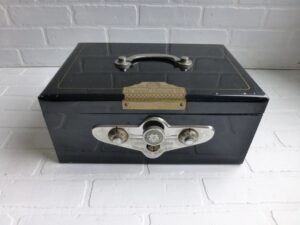
In 1919, Katsusaburo Mamiya invented a new style of lock box and opened Mamiyado Co., Ltd. as Japan’s first manufacturer of safes and lock boxes. The Mamiyado style safe proved to be very popular and spawned a large number of similar designs that were produced by many Japanese companies through the 1960s. The image to the left shows a Yamato lock box in the style of the Mamiyado safe. I was unable to find an image of an actual Mamiyado design, but I am certain it would have looked similar.
Around this same time, while attending high school, the younger Mamiya was developing an interest in photography at a young age, entering and winning several contest sponsored by local magazines. After graduation, Seiichi Mamiya helped around in his father’s shop learning how the lock boxes were made and coming up with new designs.
In 1923, after the Great Kanto Earthquake business started to slow. Mamiya and his son expanded their business to simple adding machines and early calculators. In 1926, Seiichi Mamiya would combine the designs of an adding machine with one of the company’s lock boxes, producing Japan’s first cash register. In 1926, Mamiyado would start selling the “Mamiya style cash register”. At first, demand was very low as imported cash registers were well popular, but by 1928, respect for domestic produced products improved, allowing the Mamiya cash register to be more successful.
That same year Mamiyado’s cash register would win an award for design at a Japanese trade show and at that show, Seiichi Mamiya would be introduced to Aiichiro Fujiyama, the son of Raita Fujiyama and president of Japan Cash Register Co., Ltd, which would later become part of the international company NCR. Fujiyama would convince Mamiya to come work for him and produce Mamiya’s cash register for his company.
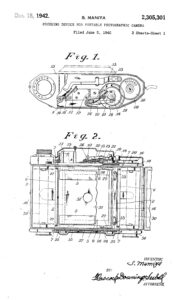
Mamiya would work for NCR until 1937, at which time he would leave the company to pursue his earlier interest in cameras and photographic equipment. At this time, Mamiya was part of a Japanese Leica user’s group and had published some instructional information on Leicas and photography. In July 1939, Mamiya would patent a new type of back focusing design in which focusing the camera was done by moving the film plane, rather than the lens.
In May 1940 a new company called Mamiya Kōki Seisakusho or Mamiya Optical Works was created and later that year introduced it’s first camera called the Mamiya 6. As a fan of the 35mm Leica, it is not clear why Mamiya chose a 6cm x 6cm medium format camera as his first design, but whatever the reason, the Mamiya 6 would go into production as early as October of that year. The camera and it’s focusing design would also be patented in the United States as US2305301A.

The Mamiya 6 would be almost constantly updated and improved with changes to it’s shutter, lens, and rangefinder system. The camera would also continue to be produced during World War II, unlike other Japanese makers who switched their factories over to producing goods for the war effort.
According to the Mamiya 6’s camera-wiki page, at least five major variants of the camera were produced during the war. Within these five versions of the Mamiya 6, a very large number of lens and shutter combinations can be found.
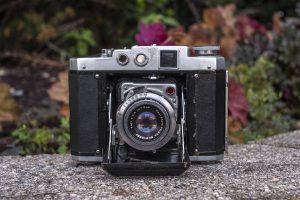
Seiichi Mamiya was a talented mechanical engineer, but lacked experience producing lenses and the precision parts needed for leaf shutters. In addition, due to supply shortages during the war in Europe and rising tensions in the Pacific, having a reliable supply of glass and fine parts was difficult to maintain. When a customer went in to buy a Mamiya 6, they could choose from whatever lenses and shutters were available, or they could optionally have their own shutters and lenses installed. This resulted in versions of Mamiya cameras found with lenses made by Fuji, Nippon Kogaku (Nikon), Takatiho (Olympus), Tōwa Kōki, and others. Shutters made by Copal, NKS, Seikosha, Lotus, and even the German company Deckel have been found, making the total combination of Mamiya 6s produced difficult to count.
Production continued during the early part of the war, but in March 1945, Mamiya’s offices and factories in Hongo, Tokyo were destroyed by US bombing raids, forcing the company to suspend operations.
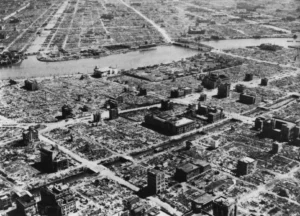
After Japan’s surrender to the United States in August 1946, there was immense pressure by the Allied Forces to restore Japan as a central hub for trade in the Pacific region. Increasing interest by the Soviet Union and what would eventually become Communist China required a complete rebuild of the Japanese economy and manufacturing industries.
Photographic and optical equipment was an easy choice as the Japanese had proven to be adept at building quality optics, lenses, and cameras before and during the war, plus with supplies from Germany non-existent, the Allied Occupation Forces saw this as a good opportunity to bring in money to the country.
Within two months after Japan’s surrender to the United States in August 1945, US Occupation Forces began to solicit applications from Japanese companies able to resume production of goods that could be exported out of the country to bring in much needed money. Many firms including Mamiya applied, and in early 1946 were approved.
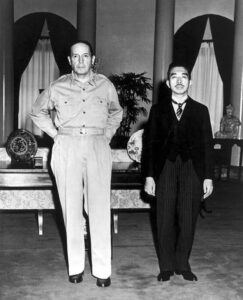
In an effort to avoid multiple companies from stepping on each other’s toes and cluttering up the supply chain, on January 22, 1946 at the Marunouchi Industrial Club in Tokyo, a conference was held to facilitate cooperation between the various Japanese firms who had applied for reinstatement. A total of 17 firms attended the conference and agreed to work together, sharing resources in an effort to restore production as quickly as possible. Included in the 17 were Mamiya, Nippon Kogaku (Nikon), Konishiroku (Konica), Tokyo Kogaku (Topcon), Chiyoda Kogaku (Minolta), Canon, Fuji, Takachiho Optical (Olympus), Tomioka Kogaku, and a few others.
Unable to return to their original factory, in January 1946 Mamiya would buy a building in Tokyo and rebuild the entire company. The first postwar cameras were assembled from salvaged parts, materials, and designs. The prewar Mamiya 6 II and III were produced, with the only difference being additional flash synchronization of the model III.
The first Mamiya cameras produced after the war were sold entirely to Allied Forces and not to the Japanese public. In July 1946, Allied Occupation Forces approved the sale of 13 folding cameras to be sold domestically to Japanese customers. Of the 13 models, the Mamiya Six III, along with the Konishiroku Pearlette and Baby Pearl, Olympus Six, and Tokyo Kogaku Minion II were chosen. More advanced folding roll film and 35mm cameras would be added to the approved list later in 1947.
In 1947, a new model called the Mamiya 6 IV would be released which omitted the waist level viewfinder and came with a cleaner top plate. Like the prewar cameras, early postwar cameras came with a large variety of shutter and lens combinations as supplies and raw materials were still in short order. Seikosha, Copal, Rectus, and NKS shutters were still common, as were Olympus Zuiko and Tokyo Kodaku Similar lenses.
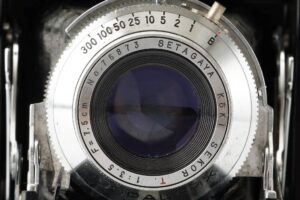
In 1947, Mamiya would purchase an unnamed Japanese lens maker located in Setagaya, Tokyo and in 1950 would integrate them as a dependent company called Setagaya Kōki K.K. Around this time, Setagaya’s own Neocor shutters and Sekor lenses became common on Mamiya 6 models, although some third party combinations were still available.
It is not clear how long the Mamiya 6 models II and III were produced, but it is widely agreed that the model IV was the only model produced by the end of the 1940s through 1953 when the model V came out which added dual format capability for both 6cm x 6cm and 4.5cm x 6cm images with integrated exposure counter. In 1955, a model called the Model IVB which had features similar to the Model IV, but with a revised top plate with larger and squared off viewfinder and rangefinder windows. Around this time a Model K and Model K2 which debuted as lower end cameras without the exposure counter, instead relying on the red window in the film door for film advance. The final Mamiya 6 models were the Automat and Automat 2 which added a coupling between the film advance and the shutter release.
In total, twelve different versions of the Mamiya 6 were produced, with many more subtle cosmetic differences and those with different lens and shutter combinations. Identifying which model is which is complicated as the cameras themselves do not identify which one they are. All cameras simply have the logo Mamiya 6 engraved into the top plate and some embossed into the body covering. To help identify each model, here is a short summary of each Mamiya 6 and it’s major features:
-
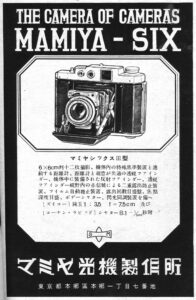
Early version of the camera spelled the name Mamiya Six, but the name was changed to the numeric 6 shortly after the war. Model I – Original model, waist level viewfinder, coupled rangefinder with round windows, strap eyelets
- Model Ia – Variant of the Model I with a larger shutter plate for larger “00 style” shutters, and slightly different folding struts
- Model II – Similar to original model with same features except no strap eyelets, also produced after the war
- Model IIa – Same as Model II with the larger shutter plate from the Model Ia
- Model III – Added flash synchronization, automatic exposure counter, and double image prevention, no option for ’00’ shutters, also produced after the war
- Model IV – First new postwar design, same as Model III but without waist level viewfinder
- Model V – Added dual format 6×6 and 4.5×6 capability, still with automatic exposure counter
- Model K – Same as Model V, but without automatic exposure counter, uses red windows
- Model IVB – Same as Model IV but with revised top plate featuring larger and squared viewfinder and rangefinder windows
- Model K-II – Same as Model K, but with the revised top plate and windows of the Model IVB
- Automat – Added coupling between the film advance and shutter to automatically cock the shutter after advancing the film
- Automat 2 – Multiple sources online confirm there was a second Automat model, but I cannot figure out what changes it had
The Mamiya 6 was still offered new until 1958 with production likely ending the year before. The end of the line for this camera had little to do with it’s quality or capabilities as a camera, rather it was due to a general shift in the camera buying public. By the end of the 1950s, folding medium format cameras had fallen out of favor to more capable and easier to use 35mm cameras. Entry level cameras produced decent images and with the dawn of the auto exposure “Electric Eye” era cameras were accessible to those with little to no camera knowledge.
What About the Mamiya 6 Model VI: Although there is no evidence that a Mamiya 6 Model VI existed, or was even planned, based on what was coming out at the time, had a Model VI been developed, it would have almost certainly had some sort of uncoupled selenium exposure meter, and possibly even a fully automatic film transport in which feelers could detect the start of a new roll of film, completely omitting the need for a red window.

Mamiya would expand their product lineup to include a huge number of cameras, from medium format SLRs like the M645 and RB67, TLR like the Mamiyaflex and Mamiya C-Series, 16mm Subminiature cameras, 35mm SLRs, 35mm rangefinders, and eventually 35mm point and shoots. Mamiya would become somewhat of an OEM maker of cameras for other companies, producing cameras sold by Nikon, Canon, Ricoh, Argus, Tower, and many others.
Mamiya’s success would hit a roadblock in the early 1980s when the company would flirt with bankruptcy. Unable to compete in a significantly more competitive market, along with the demands of increasing electronics in cameras, Mamiya would go through a major restructuring. The company would discontinue development of all their 35mm cameras and would focus entirely on their professional and semi professional medium format cameras, a segment that Mamiya was the most successful with.
Today, there is a pretty strong demand for medium format cameras that shoot 6cm x 6cm images. By far, the most desirable models are Twin Lens Reflex cameras like the Rolleiflex and Minolta Autocord, however folding 6×6 cameras like the Mamiya 6 are not far behind. The advantage of these cameras is obviously their more compact and portable size, but in that they often deliver just as good of an image quality as their much larger solid bodied cameras.
There were a huge number of folding 6x6s made by Japanese companies in the mid 20th century, but the Mamiya 6 is near the top of those models in terms of build quality, image quality, and features, plus they are the only ones with the moving focal plane feature. If you are interested in checking out one of these cameras, there were a large number built and quite a few variations. The later ones are a bit more advanced and user friendly, and likely can be found in usable condition, but all should be affordable by most collectors or users. This is a camera deserving of being in your collection and one you should consider.
My Thoughts
A common question people new to camera collecting or shooting ask is “what is a good first medium format camera?” This is a bit of a loaded question of course as there’s literally zillions of options, from high end SLR systems like the Pentax 67, to twin lens reflexes like the Rolleiflex, classic 6×9 folders, and huge numbers of simple Kodak box cameras.
And while there are a huge number of excellent recommendations in those vague categories of medium format cameras, whenever I am throwing my advice into the conversation, I usually recommend a 6×6 folder. The beauty of 6×6 folders is that the square size offers a nice balance of economy for 120 roll film. Twelve images is more than eight from a 6×9 camera, but offers a greater image size of smaller 4.5×6 cameras. Square images also give you the flexibility to frame your image anyway you want as the image is the same no matter the orientation of the camera, but then you can crop the image in post processing of you so choose.
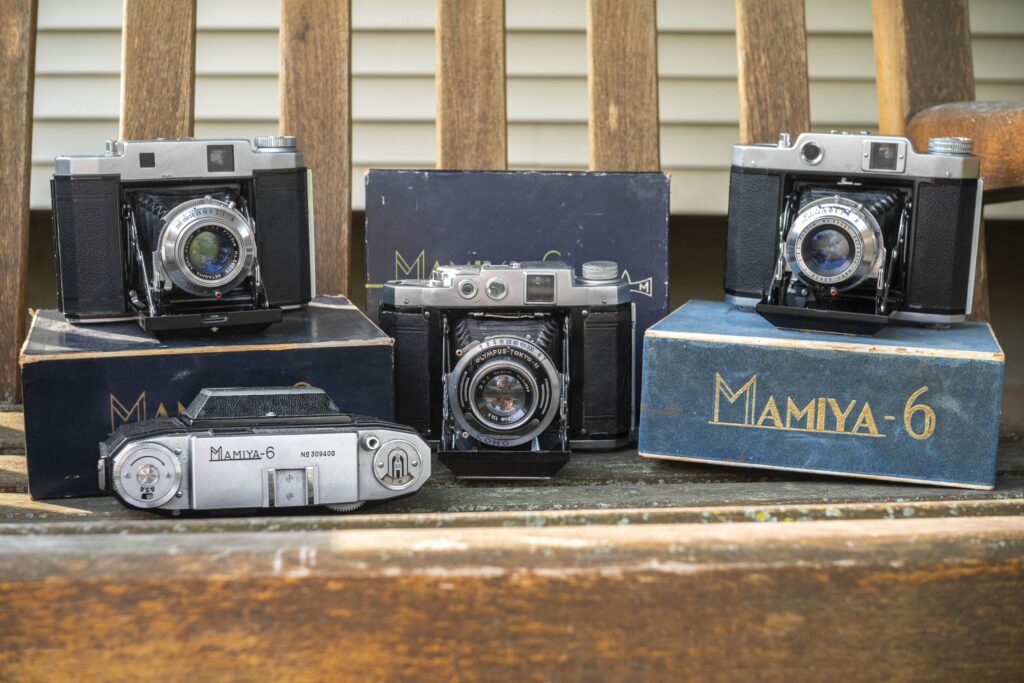
Another advantage of the 6×6 folder is that as the name suggests, these cameras fold up when not in use, which makes them much more compact and easy to carry with you than a solid bodied TLR or medium format SLR.
Finally, there’s a ton of options that range in price from affordable to dirt cheap. On the dirt cheap end of the spectrum, we have cameras like the Ansco Speedex, and on the high end rarities like the Super Fujica-6. Smack dab in the middle though, is a camera that strikes what I consider to be the perfect balance of compact size, capable of excellent images, easy and fun to use, and not that expensive, the Mamiya 6.
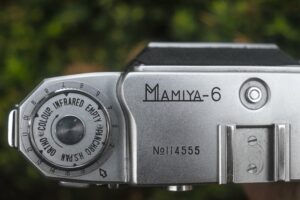
In my time reviewing cameras, the Mamiya 6 eluded me. I had certainly seen them, but none came my way in good enough shape to make it worth my while. Then, on an episode of the Camerosity Podcast from early in 2023 when the topic turned to Mamiya, I was demanded by listener and huge Mamiya 6 fan, Mike Ahmadi that I must review one. Mike was so passionate about the Mamiya 6, he offered to send me one from his collection that was in perfect working order. How could I resist?
When the Mamiya arrived, I remarked at how solid the camera felt. While most mid century folding cameras are built to a pretty durable level of quality, the Mamiya 6 clearly was a step above something like an Ansco Speedex Reading about the camera’s features, I became very excited about it’s focusing system in which the film plane moves forward and back rather than the lens and shutter. While this likely adds complexity to the inside of the camera, everything needed for accurate focus is protected by the body, rather than sticking out there on the front of the camera, exposed by struts which can become bent or damaged. While I don’t know the exact reasons the designers at Mamiya decided to do it this way, I have to imagine that continued accuracy of the focusing system was at least one reason it was done.
The camera is quite heavy and fairly large. Weighing 844 grams without film in it, the Mamiya 6 is heavier than many late 20th century SLRs with lenses. This is a substantial piece of leather and glass without any perceptible weight saving measures taken in it’s design.
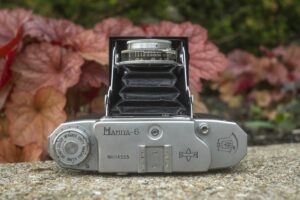
Up top the Mamiya 6 starts with a combined film advance knob with a film reminder dial on top and exposure counter beneath. Although this camera is primarily designed to shoot twelve 6cm x 6cm images per roll of 120 film, it does have the ability to shoot sixteen 4.5cm x 6cm images using a mask that would have come with the camera.
In the center of the top plate is a round button for releasing the front door of the camera and behind it an accessory shoe. To the right is the cable threaded shutter release and a depth of field scale which is coupled to the focus knob
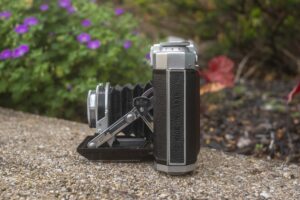
The camera’s left side has a traditional latch for opening the film compartment. Pull up on a chrome tab at the top of the latch and the right hinged rear door swings open. The sides of the Mamiya 6 lack any sort of tripod lugs which means the only way to carry it around with you is using the original ever-ready case. The heft of this camera would have definitely benefitted from being able to use your own straps. Also notice the engraved Mamiya “S/M” logo on the side of the struts.
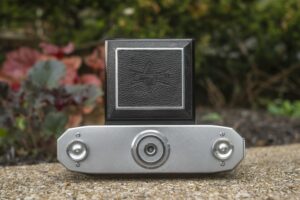
Flip the camera over and on the bottom are two feet which are used to pull down on the spool mount inside the film compartment for easier film loading and a raised pedestal in the center with a 1/4″ tripod socket. The central location of the tripod socket allows for good balance for when the camera is mounted to a tripod.
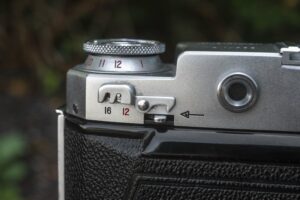
The back of the Mamiya 6 has a few controls you don’t normally see on folding 6×6 cameras. In the upper left is a lever with two notches that set the exposure counter for either 12 or 16 exposures. Changing this lever has no effect on the film transport or any other part of the camera, just the exposure counter. A lever beneath it with an arrow pointing to the left is the exposure counter lock release. Under normal operation the exposure counter on the camera prevents you from winding past the next exposure. It also allows you to infinitely wind the film spool at the end of a roll of film. Pressing this lever to the left while rotating the knob allows you to overcome this lock, which is necessary to start off a new roll of film.
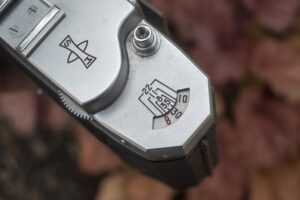
In the upper right corner is the focus knob, whose location is ideal both for controlling the coupled depth of field scale on the top plate of the camera, but also for moving the Mamiya 6’s unique moving focal plane. Unlike most folding cameras in which the lens and shutter move in a helicoid, the film plane moves, changing focus from minimum distance to infinity.
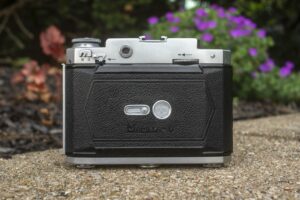
Finally, in the center of the door is a peep hole with sliding door for viewing the exposure numbers on the film backing paper. This door is only needed when loading in a new roll of film. You advance the film until you get to the first exposure number and then use the camera’s built in exposure counter for everything else. Later versions of the Mamiya 6 would omit this door altogether, relying on the exposure counter for everything. One benefit to this window however, is that in the event that the film transport malfunctions, you can still manually count off exposures by looking through this window.

A consequence of the Mamiya 6’s unique focusing system is that changes needed to be made to the way the film is held flat against the plane. Normally a flat pressure plate suspended by some springs or clips connected to the inside of the rear door handle all film flatness duties, but when the film plane moves, you need a pressure plate that moves with the plane, and one permanently mounted to the door wouldn’t suffice.
To overcome this obstacle, the designers at Mamiya designed a removable film pressure plate that sides into notices in the film gate. When the focus knob is turned and the film plane moves, the pressure plate moves with it.
When opening the back of the Mamiya 6, the back of the pressure plate is visible with a round hole for the exposure number window and a sticker explaining how to remove and reinstall the pressure plate. While the removable pressure plate accomplishes the task it was intended to do, it sets up the camera for catastrophic failure if someone were to lose this plate. If you are in the market for a used Mamiya 6, make absolute sure this pressure plate is included with the camera. If you open the rear film door and do not see the pressure plate as in the previous image, you will not be able to use the camera.
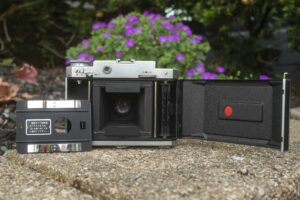
Removing the pressure plate is as easy as simply sliding it in the direction of the arrow. Without film in the camera, it slides very easily, but after loading in a new roll of film, you must put it back by sliding it in from the right side, once again, in the direction of the arrow.
The removable pressure plate adds an additional step to loading film in the Mamiya 6, however the exposure counter does as well, which requires additional explanation, especially if you do not have the original manual.
Film Loading: Mamiya 6 models with the automatic exposure counter have an interlock that prevents you from over winding the film past an exposure number. With the counter at any number 1 through 12, you cannot advance the film until you press and hold the little tab beneath the advance wheel while turning. At the end of a roll of film, you should be on exposure 12, and this is the only setting in which the interlock is disabled so you can continuously turn the advance wheel for loading in a new roll of film. Once you have a new roll of film loaded, press the little tab once while turning the knob to advance the film to the first exposure and you are ready to go. If somehow, you find that the exposure counter is at any number other than 12 when loading in a new roll of film, you must keep turning the knob with film out of the camera until you get there, at which point, you can load your film.
Aside from the pressure plate, film loading is the same as other 6×6 folding cameras. A new roll of film loads on the right and transports to an empty take up spool on the left. To make getting each spool in and out of the camera, pull down on the two round feet on the bottom of the camera, beneath each chamber. This pulls the spool shaft out of the way, making it easier to move the spools. Since this model uses the red window to set the first exposure on a new roll of film, there is no need to advance the film to a Start arrow, like on later Mamiya 6s.

The Mamiya’s viewfinder is similar to most 6×6 folding cameras in that it is a large and roomy square with a rangefinder patch in the middle and nothing else. This camera predates the use of projected frame lines or any sort of exposure information. Contrast between the greenish main viewfinder and rangefinder patch is good enough to get accurate focus in all but the dimmest light.
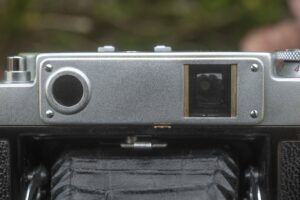
When shooting the Mamiya 6 Model V with the 4.5cm x 6cm mask in place, a small lever inside the opening for the front door directly above the door latch controls two small masks on either side of the viewfinder, giving an approximate 4.5×6 image. Later Mamiya 6 models omitted this switch, and instead put in a tinted piece of plastic on the sides of the viewfinder to indicate both formats.
What I like the most about the Mamiya 6 Model V is that it’s close enough to other 6×6 folding cameras that it’s easy and simple enough to use. If this is your first time using one, film loading is a bit more complicated and something you really should practice before taking important shots, but the rest of the camera is very intuitive. The thumbwheel focus is very convenient and makes using the camera a joy. I suspect that after prolonged use of this camera, going back to other folders with front cell or front group focus would seem like a huge step backward. Mamiya clearly put in a lot of effort to make the best camera they could, without alienating anyone. The only thing that’s left now is to load in some film and shoot it, so let’s get going!
My Results
My time with the Mamiya 6 was short, so I took it out for an early spring shoot in March 2023 loaded with two rolls of film. The first was a semi expired roll of Fuji Neopan 100, and the second a fresh roll of Kodak Gold 200. I had shot some of the same Neopan stock before and knew it shot close to box speed with little age degradation, and of course, the Kodak Gold was fresh, so it was shot at box speed.
Mamiya cameras generally have a good reputation for quality and Olympus Zuiko lenses share the same overwhelmingly positive reputation, so what happens when you put the two together?
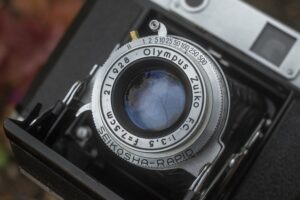
In this case, two positives don’t equal a negative as the images I got from the Mamiya 6 were as good as any medium format camera I’ve shot, regardless of size, shape, brand, or age. Sharpness was excellent corner to corner with no softness anywhere near the edges. Contrast was excellent both while using the Fuji Neopan and the Kodak Gold 200 film. Vignetting nor any other optical anomaly often associated with lesser lenses was nowhere to be found. It is clear that even in their early days Olympus, and their predecessor Takachiho, was on top of their game as a lens maker. I did end up with strange color casts with the Kodak Gold film as a result of a brain fart when developing. This was entirely my fault and not that of the camera whatsoever.
The signature feature of the Mamiya 6 is it’s focal plane focus with thumbwheel focus. Mamiya wasn’t the only company to implement a thumbwheel focus, as both Fuji and Voigtländer did it as well, but instead of just being a curious design oddity in an otherwise normal focusing camera, the Mamiya 6’s system works quite well. I found the location and ease to which I could focus my image to be very easy. The wheel is ideally located to where your right thumb naturally rests, and has a serrated edges which makes gripping it a snap. A full motion from minimum to infinity focus cannot be done with a single motion as it requires just a bit farther than the wheel can turn before you have to move your finger, but in practical use, you likely won’t often shoot too many consecutive shots at such extreme variances in distance.
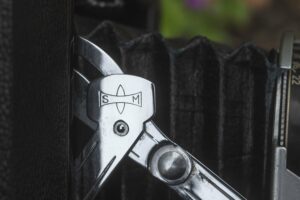
I also appreciated the automatic exposure counter which worked quite well and avoided some of the complexities of similar systems found on other cameras which are prone to failure. Instead of using feelers inside the film compartment to detect the movement of film, the Mamiya 6 simply counts revolutions based on known distances between frames. I have no proof of this, but I suspect that there could be some variance in the frame spacing using films with a different thickness of backing paper, but I did not find that to be true in the two rolls I shot. Many cameras like the Rolleiflex or the Soviet KMZ Iskra who use such feeler systems fail over time as parts get worn out or dirty, not so on the Mamiya.
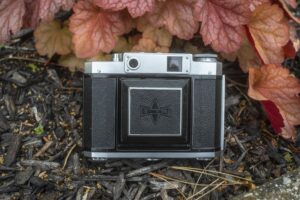
For such a well thought out and high quality camera, it was a little disappointing that Mamiya couldn’t have worked out a coupling between the shutter and film transport so that you don’t need to manually cock the shutter before each shot. This is a feature they would later include with the Mamiya Six Automat from 1955, but it would have been nice if it were included sooner.
Finally, although this wasn’t a problem with this example, I have to imagine that a good deal of used Mamiya 6 cameras out there are missing the film pressure plate. While I completely understand the need to connect the pressure plate to the body, rather than the door, many other companies went with a hinged pressure plate which I think Mamiya should have at least considered to eliminate the chance that the plate gets separated from the camera.
The viewfinder compared to other good 6×6 medium format rangefinders, which is to say good. If your only experience with combined image rangefinders is on 35mm cameras, the one on the Mamiya 6 still seem large and room to you, but in reality, it works pretty much the same way.
Overall, the Mamiya 6 is a heck of a camera and is definitely deserving of it’s praise as one of the most highly recommended medium format cameras out there. Prices have come up on them in recent years, especially the later models like the V, IV B, and Automat, but they’re still a bargain compared to other 6×6 TLRs like the Rolleiflex, or folders like the Zeiss Ikon Super Ikontas.
If you are looking to get into medium format, or already have dabbled in it, and want a really nicely built and capable 6×6 camera with good ergonomics and build quality, an excellent lens, and won’t break the bank, the Mamiya 6 is a great option and one that I definitely recommend!
Related Posts You Might Enjoy
External Links
http://camera-wiki.org/wiki/Mamiya_Six
http://herron.50megs.com/history.htm

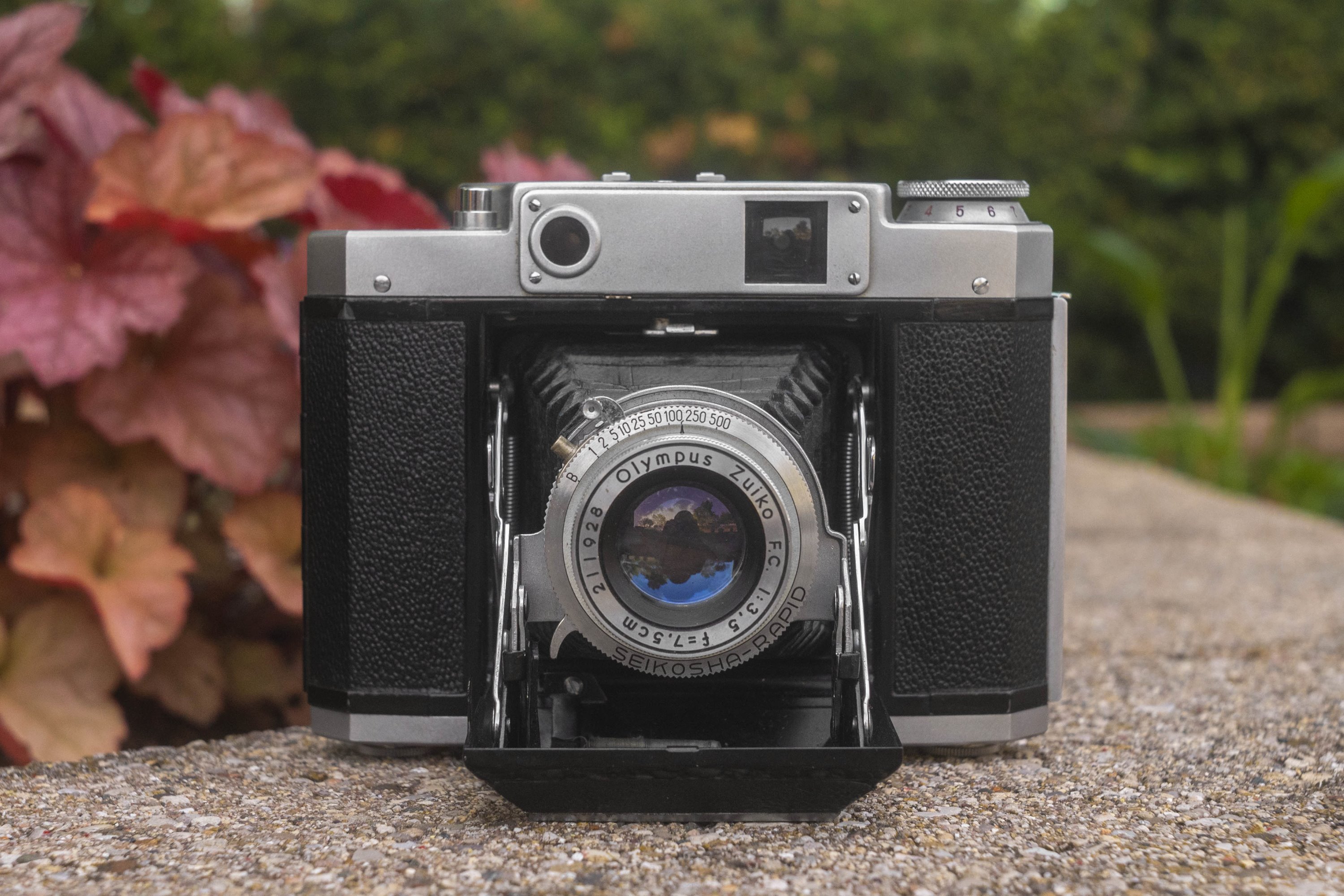
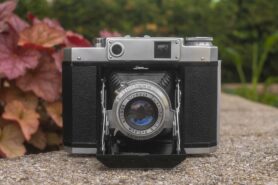
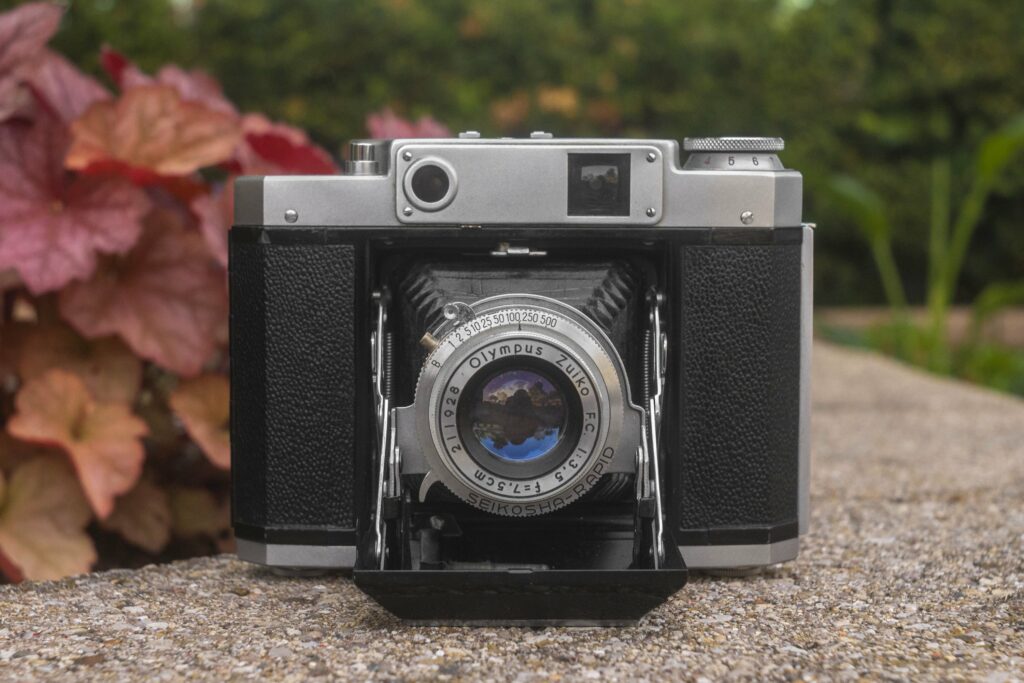





















Great, detailed review – thanks, Mike. Question: On any camera with a moving pressure plate, how does one collimate focus after a teardown and shutter CLA?
Thanks, Mike! I’ve had my eye of one of these for a while. After reading your treatise, I’m ready to grab one.
Hi Mike. Thanks for your article. As always, very comprehensive. I’ve had a Mamiya-6 Kii with a Setagaya Koki 75mm f3.5 lens for a few years now and have found it to be excellent. You mention a hinged pressure plate as being something Mamiya could have added. My camera has a pressure plate hinged from the bottom. I think my camera is from 1958, so near the end of Mamiya-6 production.
I’m glad you found the Mamiya 6 as awesome as I said it was. They have been sleeping giants for quite some time. I’m sure now that you have reviewed it the cameras will become more popular and prices will go up. As always your very detailed reviews set the standard for classic camera reviews and this one will definitely be the de facto goto for anyone who wants a detailed history of these cameras.